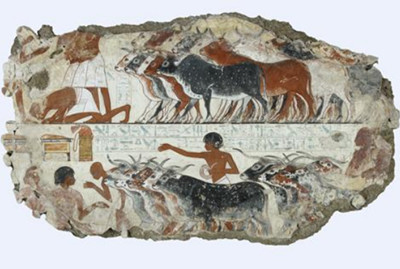Mention excavation in Egypt, and most of us immediately see ourselves entering Tutankhamun's tomb, discovering the hidden treasures of the pharaohs and at a stroke rewriting history. Aspiring archaeologists should be warned that this happens only very rarely.
提及在埃及的考古挖掘,我們絕大多數人自然而然地就聯想到進入圖坦卡蒙的法老陵墓,挖出隱藏多年的法老大寶藏,于是乎,一夜改寫世界歷史,一舉成名天下名。可別說我要打擊那些胸懷抱負、滿腔熱情的未來考古學家啊,事實上這種情況是極少發生的。
Most archaeology is of course a slow dirty business, followed by even slower recording of what has been found. And the tone of archaeological reports has a deliberate, academic, almost clerical dryness, far removed from the riotous swagger of Indiana Jones.
大多數的考古工作真是又累又苦,又慢又臟;逐一記錄下發掘出來的有用沒用的物品的過程,就更別提有多緩慢了。而且考古報告的基調幾乎千篇一律的學術味十足、幾乎是文書干燥的調調,與大家印象中“守寶奇兵”的繽紛招搖可是相去甚遠。
In 1900, a member of the Egypt Exploration Society excavated a grave in southern Egypt. He soberly named his discovery Grave A23 and noted the contents:
1900年,埃及探索學會的某一成員在埃及南部發掘處一處墓葬,他正而八經地將這發現命名為墓A23,并記錄其中發現成果如下:
'Body, male. Baton of clay painted in red stripes, with imitation mace-head of clay. Small red pottery box, four-sided, 9 inches x 6 inches. Leg bones of small animal. Pots and - stand of 4 clay cows.'
“遺體,男性。泥塑棍棒,表面涂有紅色條紋,頂端是仿狼牙棒頭。方型小陶盒,四面9英寸x 6英寸,內裝:小動物腳骨。陶罐若干,站立式四牛泥塑模型一件。”
These four little clay cows are a long way from the glamour of the pharaohs, but you could argue that cows and what they represent have been far more important to human history. Babies have been reared on their milk, temples have been built to them, whole societies have been fed by them, economies have been built on them. Without cows there are no cowboys, and without cowboys no Wild West. Our world would have been a different and a duller place without the cow.
當年這四只小小的陶牛與法老們輝煌與偉大真是無從相比,然而你也可以這么說,這些陶牛及其代表的意義在人類歷史上可以占有更加重要的地位。人類的嬰兒喝著牛奶成長,人類建立起供奉牛的神廟。沒有牛就沒有牛仔,沒有牛仔就沒有美國的狂野西部文化。假如沒有牛的存在,我們的世界將會變得多么的不同與乏味啊。












